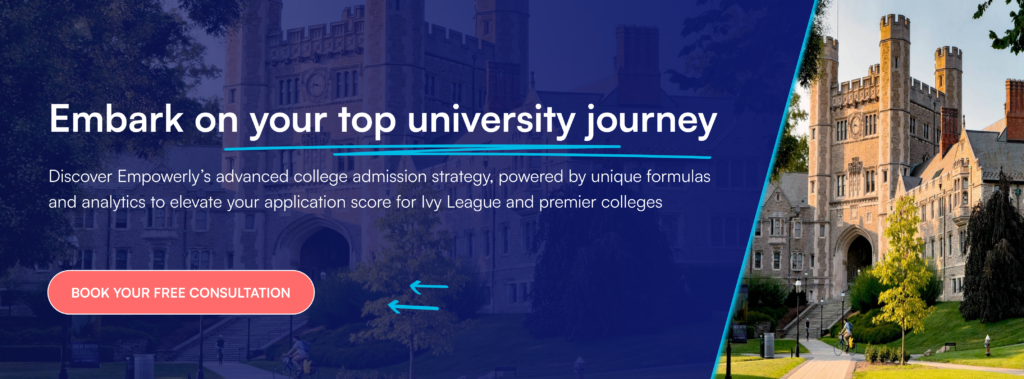Co-op programs. Access to Boston. Global campuses. These unique opportunities explain a lot of Northeastern University’s surge in popularity and increasing selectivity—but not all of it. There’s definitely more to the story. With paid, full-time work rotations baked into the degree and outcomes that rival elite peers, the demand has spiked even more dramatically of late. Northeastern now admits only a sliver of applicants it used to admit each cycle.
Curious what changed? Let’s dive into Northeastern’s 2025 acceptance rate, recent student trends, admitted profile, and expert tips to build a standout application this year.
Northeastern University: at a glance
First, let’s get to know the campus.
- Campus (location and type): Private research university in Boston, MA, with a global campus network (e.g., London, Oakland, Seattle, Toronto, Vancouver).
- Undergraduate size and ratio: ~22,000–23,000 undergrads; ~16:1 student–faculty ratio.
- Application timeline: EA Nov 1; ED I Nov 1; ED II Jan 1. (Regular Decision Jan 1.)
- Essays: Common App personal statement required; short responses or additional materials may be required for select programs (e.g., portfolios/accelerated tracks).
- Testing Policy: Test-optional for SAT/ACT (submit if they strengthen your file; English proficiency required for international applicants).
- Special programs: Signature Co-op (full-time, months-long work rotations), Honors Program, Global/First-Year pathways (London Scholars, Global Scholars), combined/accelerated degrees, robust research and industry partnerships.
If you’ve never been to Boston (or want to take a closer look at the everyday life of a Northeastern student), check out this campus tour:
Who should apply to Northeastern?
This top-ranked school may be a great fit if you:
- Thrive in fast-paced, hands-on environments
- Want to build a resume before graduation
- Are excited by the idea of rotating between campus, co-ops, and global study
- Enjoy cities and urban energy, but still want a campus identity
- Like the idea of customizing your timeline (4-year, 5-year, and 6-year plans)
That said, if you’re looking for a more traditional college experience without frequent internships or city immersion, another school might be a better fit for you.
The Northeastern acceptance rate
This year’s headline: Northeastern’s Class of 2029 acceptance rate is 5.6%, up slightly from ~5.2% last cycle. That’s still among the lowest in the country outside the hyper-selective Ivy-tier cohort.
Five-year trend (context matters):
- Class of 2025: ~18%
- Class of 2026: 6.7%
- Class of 2027: 5.6%
- Class of 2028: ~5.2%
- Class of 2029: 5.6%
So what changed over this time period? A decade of brand and application growth, expansion of first-year global pathways, and co-op’s market pull compressed admit rates dramatically, starting with the Class of 2026.
Not to mention the early round dynamics. Northeastern offers both Early Action and Early Decision, both reflecting a materially higher admit rate than Regular Decision. What should you know? Binding ED can indeed confer a sizable statistical edge, but the applicant pool is self-selecting and stronger on average.
Takeaway: Plan around a ~5–6% overall admit rate, with potentially higher odds in ED if your academics and finances align.
Average accepted student profile
What does a typical admitted Huskie look like? Northeastern is test-optional, but submitted scores and academic rigor still carry weight. In the latest Common Data Set, rigor, GPA, test scores (if provided), essays, and recommendations rank as “very important” or “important.”
- SAT (25th–75th): 1450–1520 (median ~1490)
- ACT (25th–75th): 33–35
- Class rank: ~69% in the top 10% of their high school class
- GPA: A large majority of reporting students had 4.0 (weighted scales common)
Only ~24% submitted SAT and ~7% submitted ACT, reflecting real usage of test-optional, but those who did submit posted very high numbers.

How to build a successful Northeastern application
Ready to compete? Focus on evidence of impact and fit for experiential learning. Here’s a general blueprint on how to align with what Northeastern values and publishes.
1) Lead with rigor, and show sustained A-level results
Northeastern marks course rigor and GPA as “very important.” Load up on advanced course load, if you can (especially math/science for CS/engineering; lab sciences for health; writing-heavy courses for humanities/business). Use your Additional Info section to explain any context shifts (grading policies, school moves, life interruptions).
2) Decide early: test or no test
The university is test-optional. If your practice scores sit in or above the 1450+/33+ range, strong scores can reinforce readiness. If not, redirect the time into essays and portfolio-quality projects. Either way, show mastery through transcripts, recommendations, and outcomes.
3) Make your essay “co-op specific”
A generic “I love Boston” essay won’t cut it. Instead:
- Connect your interests to co-op and project-based learning: What problems do you want to solve in a six-month, full-time role?
- Reference relevant labs, centers, or partner spaces you’d plug into.
- Show you understand the rhythm of study, co-op, study (and how you’ll use those cycles to accelerate your growth).
4) Quantify extracurricular impact, not just titles
Translate roles into outcomes: lines of code shipped, funds raised, patients served, research posters presented, dashboards deployed, policy changes adopted. When possible, tie these to career exploration. For instance, clubs that led to internships, community work that inspired your intended co-op industry, etc.
5) Build a smart timing strategy
- Early Action (11/1): Great for visibility and earlier decision without a binding commitment.
- Early Decision I (11/1) / ED II (1/1): Consider if Northeastern is the clear #1 and finances are understood; data suggest higher admit rates in ED.
- Keep an eye on scholarship and specialty program deadlines.
6) Recommendations that show you “co-op ready”
Ask teachers who have seen you collaborate, take feedback, and deliver under real constraints. Phrases that matter: initiative, reliability, communication with diverse stakeholders, iteration, resilience (all traits employers look for and that align with co-op success).
7) If admitted to a pathway, embrace it strategically
Some students begin in London or Oakland (Global/London Scholars) and transition to Boston later. These programs are bona fide Northeastern starts with strong first-year support. Use them to build global perspectives and early internships, then return with momentum.
Tips for transfer applicants:
Northeastern welcomes transfer students, but the bar is high. To boost your chances of a successful transition, try the following.
- Aim for a college GPA of 3.7+ with strong upward trends
- Use your essays to connect your past experiences with future co-op goals
- Highlight relevant internships, research, or leadership that reflect NU values
- Check program-specific prerequisites (especially for business, CS, and health sciences)

Life at Northeastern
What can a prospective student expect?
Co-op is the heartbeat.
Students alternate academic terms with full-time, paid roles across Boston hospitals, fintechs, big tech, biotech, consultancies, and nonprofits. Some students even complete two or three co-ops before graduation. Many receive return offers. That workplace immersion shapes classroom discussions and career clarity.
Boston as your campus.
Steps from research hospitals, the MFA, and startups, students blend city access with a defined campus feel (Centennial Common, Marino Center, Snell Library). The network effect is real: projects and co-ops often start with a professor’s lab or a club contact, then jump to paid work.
Outcomes that reward the hustle.
Northeastern regularly reports that nearly 96% of undergraduates are employed or in grad school within nine months, with a large share of offers flowing directly from co-op employers.
Your future: Boston and beyond
Northeastern’s 2025 acceptance rate (~5.6%) confirms what you already suspected: this is a highly selective university. But it’s also predictably selective. Students who pair A-level rigor, evidence of impact, and a clear co-op narrative put themselves in contention, especially with a smart EA/ED plan.
Here are your next steps:
- Map your deadlines (EA vs. ED I/II),
- Finalize a school list calibrated to reach/target/safety,
- Draft essays that connect your goals to Northeastern’s experiential learning model, and
- Decide on testing with data, not guesswork.
Want help turning this plan into an acceptance letter? Meet 1:1 with an Empowerly team member to build your ED strategy, stress-test your profile, and craft a co-op-ready application narrative.
